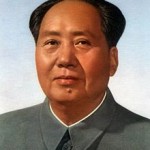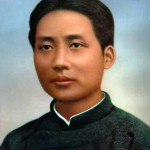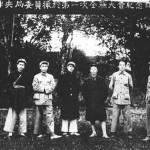
Mao Zedong (Wade-Giles: Mao Tse-tung) became the face, the figurehead and the ideological father of Chinese communism. From peasant origins in Hunan, young Mao became a busy activist, participating in literary groups, organising labour strikes and starting schools to educate workers and peasants. The May Fourth Movement sparked his interest in political movements, particularly Marxism. He became a founding member of the Chinese Communist Party (CCP) then single-handedly built up the party in his native Hunan. While others in the CCP took their direction from the Comintern and from Marxist orthodoxy, Mao was an individualist who believed that China’s peasants, not planners in Moscow, should determine the course of the Chinese Revolution. By the late 1920s Mao was living beyond the reach of the CCP hierarchy and forging his own revolutionary course. In 1930 he established a rural soviet in Jiangxi province and set about building a model socialist state, complete with a government, an army and land reform. The Jiangxi Soviet became so secure that the CCP leadership relocated there in 1932-33, a move that seemed to marginalise Mao. But Mao was too shrewd a political operator to be sidelined so easily.
Mao Zedong was born in Hunan province in central southern China, the youngest of four sons. His father owned almost four acres of land, enough for the family to be considered wealthy by peasant standards – however Mao still witnessed a considerable amount of poverty and suffering in Hunan, the worst of this during a devastating famine in 1910. Aside from a brief stint fighting with anti-Qing forces during the 1911 Revolution, most of Mao’s early life was spent as an academic under the tutelage of his future father-in-law, Yang Changji. Mao commenced teacher training in 1912, after which he was employed as a librarian, then a primary school principal. He was a voracious reader of history and politics, from classic works of Chinese literature to The Communist Manifesto. In 1919 Mao travelled to Beijing, inspired by the student activism of the May Fourth Movement; while in the capital he published essays supporting trade unionism and women’s rights. In early 1920 Mao moved to Shanghai, washing clothes by day but spending his spare time in political and literary groups. It was there that Mao was first drawn to Marxism, after mixing with Chen Duxiu and other early communists. In July 1921 he attended the first CCP congress, representing Hunan.

Shortly after the congress Mao returned to Hunan, where he set about organising and strengthening the local CCP branch. Based in Changsha, the provincial capital, Mao began building support by writing, educating and networking. He published radical essays in Changsha’s newspapers, perpetuating the spirit of the May Fourth Movement but also floating and promoting Marxist ideas. He became involved in organising Hunan’s miners, railway and textile workers, providing advice on disputes and encouraging organised strikes; no less than 20 different unions were formed in Hunan under Mao’s guidance. Mao also started night schools where Hunan’s workers and peasants could learn Chinese and mathematics; these schools were not only very popular, they were also a conduit for promoting Marxist ideas and CCP membership. In mid-1923 Mao was elected to the CCP’s executive committee and relocated to Shanghai. He also took up membership of the Guomindang, in line with Comintern instructions; Mao later headed up a nationalist propaganda bureau and in January 1924 attended the Guomindang national congress in Guangzhou. The March 1925 death of Sun Yixian (Sun Yat-sen) and the rise of Jiang Jieshi (Chiang Kai-shek) saw Mao lose his position within the Guomindang. Mao returned to Hunan and started compiling his famous Hunan Peasant Report, while organising and delivering military training to peasant militias.
“While Mao Zedong was a great revolutionary, he became increasingly despotic as a ruler, a not uncommon development in the history of revolutions. He organised the peasants of China to destroy ancient forms of oppression and authority only to replace them with the alien authority of his own deified image. He liberated the Chinese nation from the shackles of foreign imperialism – and ‘build a country’, as his successor Deng Xiaoping put it – only to shackle the people to the onerous demands of the doctrine of ‘continuous revolution’. The two sides of Mao – the revolutionary and the tyrant, the social liberator and the political dictator – cannot easily be reconciled.”
Maurice J. Meisner, historian
The year 1927 was a turning point in Mao’s life. Jiang Jieshi’s massacre of communists in Shanghai ended the First United Front and forced most of the CCP into hiding. In Hunan, Mao turned his attention to the political and military mobilisation of the peasantry, with the aim of achieving local autonomy. Mao hoped to train rebellious farmers so they could instigate uprisings to overthrow nationalist authorities or ruling warlords, after which they could create peasant soviets on the Russian model. This approach proved quite popular with peasants in Hunan, since it tapped into long-standing grievances and dissatisfactions. In September 1927 Mao led an unsuccessful peasant rebellion in Hunan and neighbouring Jiangxi. Dubbed the Autumn Harvest Uprising, it was thwarted by inadequate numbers and poor leadership; Mao and his ally, military commander Zhu De, were forced into hiding in the Jinggang mountains, while Mao was sharply criticised by the CCP Politburo for exceeding his authority. Mao’s forces spent the next 18 months either in hiding in the mountains, searching for a new base or resisting attacks from Jiang Jieshi’s nationalist army.
In early 1929 Mao and Zhu De led their armies into southern Jiangxi. In February 1930, after a year of consolidation, Mao and his supporters formed the Jiangxi Soviet, an attempt to create a self-governing, self-sustaining rural base. Mao envisioned the Jiangxi Soviet as both a military stronghold against the nationalists and a laboratory for the trialling of communist economic and social policies. Some of Mao’s military reforms and land redistributions proved unpopular with other party officials in Jiangxi; he dealt with these dissenters and political opponents by branding them “rich peasants” and “counter-revolutionaries”. In late 1930 Mao initiated a series of purges to remove Jiangxi CCP and Red Army leaders hostile to his own leadership. The Futian incident, as this purge became known, saw hundreds of Mao’s opponents arrested and silenced with brutality and executions; confessions were sometimes extracted from suspects by torturing their wives. These purges went on for the duration of Mao’s leadership in Jiangxi, with historians estimating the total number of deaths between 10,000 and 70,000. Mao himself was no stranger to political violence. In late 1930 pro-Guomindang warlords captured and executed his sister, Mao Zehong, two of his sisters-in-law and Mao’s estranged wife Yang Kaihui.

Mao spent 1931 consolidating his control of the Jiangxi Soviet and implementing socialist policies and programs. In November 1931 Jiangxi was formally reconstituted as the Chinese Soviet Republic, with Ruijin its capital and Mao its chairman. The Red Army in Jiangxi numbered around 150,000 soldiers, as well as training facilities and munitions factories. Mao’s success in consolidating and fortifying Jiangxi resulted in the CCP Central Committee relocating there in 1932-33, following a police crackdown in Shanghai. Jiangxi now became the CCP’s national headquarters, a shift that eroded Mao’s authority in the rural soviet and exposed ideological differences between Mao and the party’s leadership. The CCP’s platform was still dictated by the Comintern, now represented by the German agent Otto Braun. Mao now became an outsider in the soviet he had helped to build. His view of the peasantry as a potential source of revolution was dismissed by the party leadership; his military strategies were overruled and replaced with more convention tactics. The presence of the CCP leadership in Jiangxi also made it a target for Jiang Jieshi’s encirclement campaigns during the early 1930s. These campaigns failed at first but the Jiangxi defences eventually gave way, forcing the Red Army to break out and embark on its famous Long March to Shaanxi. Mao Zedong appeared to have lost his stronghold in Jiangxi – but the Long March would provide him with an opportunity to challenge for the leadership of the CCP.

1. Mao Zedong was an important communist revolutionary who emerged as the CCP leader in the mid-1930s.
2. From peasant origins, the educated Mao later worked as a social activist in Hunan, Beijing and Shanghai.
3. He was drawn to Marxism during the May Fourth Movement and in July 1920 became a founding member of the CCP.
4. Mao organised the CCP in Hunan, assembled and trained a militia and in 1927 attempted a rural revolution.
5. In 1930 Mao and his supporters established the Jiangxi Soviet, later the Chinese Soviet Republic, where they strengthened their military while implementing socialist economic and social policies. Mao’s power was challenged when the CCP hierarchy relocated to Jiangxi in the early 1930s.
© Alpha History 2018-23. Content on this page may not be republished or distributed without permission. For more information please refer to our Terms of Use.
This page was written by Glenn Kucha and Jennifer Llewellyn. To reference this page, use the following citation:
G. Kucha & J. Llewellyn, “Mao Zedong”, Alpha History, accessed [today’s date], https://alphahistory.com/chineserevolution/mao-zedong/.
This website uses pinyin romanisations of Chinese words and names. Please refer to this page for more information.
